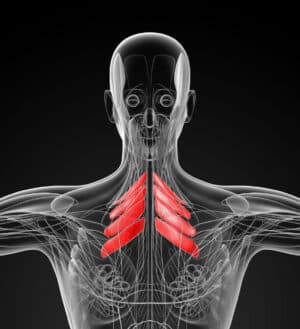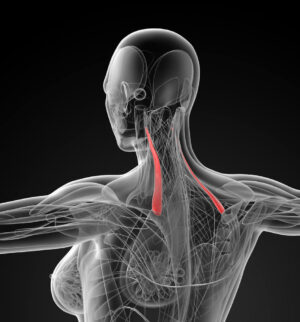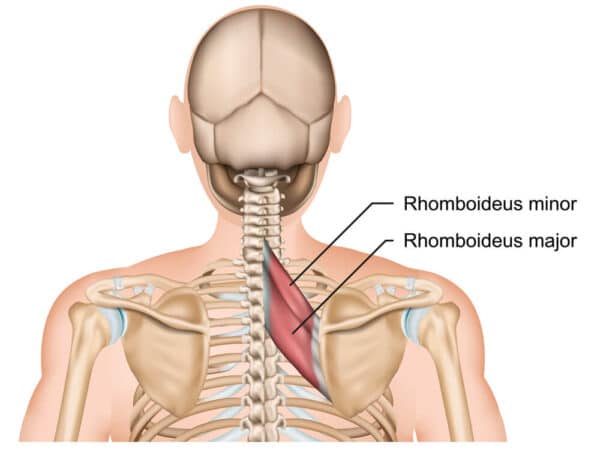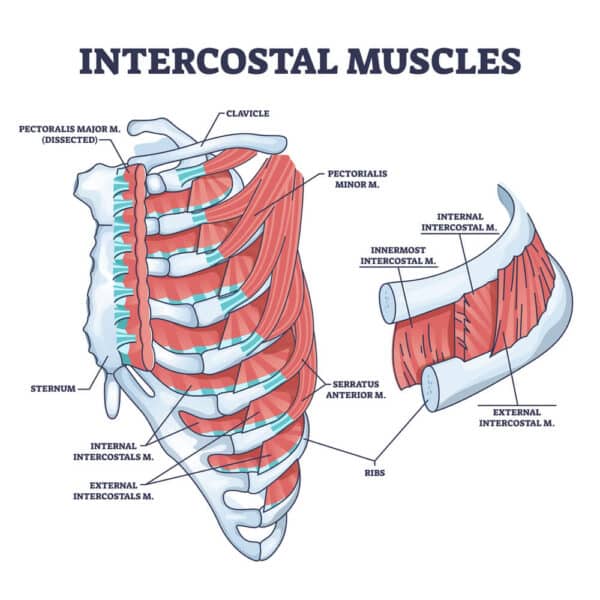The thoracic spine plays a critical role in the stability and mobility of the upper body. Comprised of twelve vertebrae and an intricate network of muscles and ligaments, it serves as a central pillar supporting the structure and movement of the body.
Understanding the role and function of thoracic spine muscles is pivotal for anyone looking to improve their posture, enhance athletic performance, or address conditions related to spinal health. In this article, we delve into the complexities of these muscles, shedding light on their importance in our everyday lives.
Groups of Muscles of the Thoracic Spine
There are a large number of muscles in the thoracic spine. They can be arranged into four major groups based upon their location.
Superficial muscles: These are the muscles closest to the skin. The superficial layer is composed of the trapezius, latissimus, and rhomboid muscles.
Intermediate: This is the layer of muscle that is beneath the superficial layer but above the deep layer. The intermediate layer is composed of the two serratus posterior muscles.
Deep muscles: Also known as the intrinsic back muscles, this group of muscles is the deepest layer of muscle. This layer includes the erector spinae group, which is composed of iliocostalis, longissimus, and spinalis.
Intercostals: This group of muscles plays a critical role in the mechanics of breathing.
In this article, the muscles of the thoracic spine will be reviewed from the deepest to the most superficial layer.
Deepest Muscle Group: the Erector Spinae Group
The principal function of this group of muscles is to extend the thoracic spine (i.e. to allow backward bending). It is composed of three key muscles: the iliocostalis, longissimus, and spinalis. These are long thin muscles that lay adjacent to one another, with the iliocostalis on the outside edge.
Iliocostalis: The iliocostalis is a thin muscle that is lateral to the longissimus. It originates from the spinous process T11-L5 and attaches onto the ribs, and it functions to laterally flex the vertebral column.
Longissimus: The longissimus is a long thin muscle situated between the iliocostalis and spinalis, and is part of the erector group. It attaches to the transverse process and provides spine extension and lateral flexion.
Spinalis: The spinalis is a long thin medial muscle that is part of the erector spinae group. It is closest to the midline of the spine and is responsible for thoracic extension, lateral flexion, and rotation.
Intermediate Group: Serratus Posterior Group
The intermediate group is composed of two principal muscles: serratus posterior superior and inferior.

Serratus posterior superior: This is a thin, four-sided muscle in the upper portion of the thoracic spine that is deep to the rhomboids. The muscle originates from the nuchal ligament and inserts on the upper borders of the second to fifth ribs. Its principal function is to elevate these, aiding in respiration.
Serratus posterior inferior: This is a thin, flat muscle situated at the junction of the thoracic and lumbar spine. It has a quadrilateral shape and is situated deep to the latissimus dorsi. It originates from the spinous processes of the T11-L2 and inserts on the inferior borders of the ninth to twelfth ribs. It depresses the lower ribs, aiding in expiration.

Superficial Group: Closest to the skin.
The superficial group is composed of three principal muscles: trapezius, latissimus, and rhomboid muscles.
Trapezius: The trapezius is the famous trapezoid-shaped muscle seen in many athletes. It originates from the base of the skull and extends onto the posterior border of the clavicle, acromion process, and spine of the scapula. It functions to rotate, elevate, and depress the scapula.

Levator scapula: This is a thin muscle located on the back and side of the neck. It is named for its action: levator means lift. Scapula refers to the wing blade on the back side of the shoulder. The levator scapula elevates. It originates from the transverse processes of C1-C4 and attaches to the medial border of the scapula.

Rhomboid muscles: These are two important, diamond-shaped muscles that are deep to the trapezius.
- Rhomboid major is the larger of the two rhomboid muscles and connects the scapulae to the vertebrae. It originates from the spinous processes of T2-T5 and inserts on the medial border of the scapula. It is inferior to the rhomboid minor. Its principal function is to pull the scapula towards the spine (retraction).
- Rhomboid minor is a small muscle that works together with the rhomboid major to retract and rotate the scapula. It originates from the nuchal ligament and spinous process of C7-T1. It inserts above the rhomboid major on the medial border of the scapulae.

Intercostal Muscles
The intercostal muscles are a group of muscles located between the ribs. They play an important role in breathing, as they expand and contract the ribcage. There are three layers of intercostal muscles.
External intercostals: These are the most superficial of the intercostal muscles. Their orientation is diagonal, and they originate from the lower border of a rib and insert into the upper border of the rib below. During inspiration, the external intercostal muscles contract to lift the ribcage upward and outward, drawing air into the lungs.
Internal intercostals: These lie deep to the external intercostal muscles. They are diagonally oriented in a direction opposite to those of the external intercostal muscles.
Innermost intercostals: These are the deepest layer of intercostal muscles and are involved in exhalation. Along with the internal intercostals, they assist in depressing the ribcage, which expels air from the lungs.

How Do the Muscles of the Thoracic Spine Work?
The muscles of the thoracic spine are essential for maintaining posture, stability, and various movements. The five most important roles of the thoracic spine muscles are:
- Posture: It takes significant strength and stamina to keep the human body upright. The natural tendency of the upper torso is to slump forward. This is aggravated by sitting at a desk, extensive screen time, and driving for prolonged periods. Strong, balanced thoracic muscles help maintain an upright posture. Weak, unbalanced muscles can lead to head forward posture and kyphosis (rounding of the back).
- Spinal stability: There are four major groups of muscles in the thoracic spine. These include the superficial, intermediate, deep, and intercostals. These muscles, in combination with the multifidus muscle, provide stability for the thoracic spine. Collectively, they protect the thoracic spine and spinal cord from excessive movements such as rotation, flexion, and extension.
- Breathing: The intercostal muscles are a group of thin muscles situated between the ribs. There are the external, internal, and innermost intercostal muscles. They play a critical role in breathing, helping to expand and contract the rib cage during inspiration and expiration.
- Shoulder stabilization: The trapezius, rhomboids, and serratus are critical for stabilizing the scapula (shoulder blade). They stabilize the shoulder joint by anchoring the scapula against the ribcage.
- Overhead activities: Activities that involve raising the arms overhead, such as reaching objects high on a shelf, swimming, tennis, and weightlifting, depend upon the thoracic spine muscles. They help lift the scapula and stabilize the shoulder joint.
Spine Muscle Injuries and Conditions
Thoracic spine muscle injuries can compromise posture, breathing, spinal stability, and shoulder stability. There are many different types of injuries. The most common include:
Thoracic Strain
A thoracic strain is an injury to the muscle and/or tendon. A strain is a common medical injury and is graded based on severity. There are three grades of strains:
- Mild strain: A mild strain is an isolated stretch injury to a limited number of muscle fibers. Injury can be associated with mild discomfort and stiffness that recovers quickly.
- Moderate strain: This is partial tearing of the muscle that is typically associated with significant pain, swelling, and a decrease in muscle strength.
- Severe strain: A severe strain is a complete rupture of the muscle or tendon such that the muscle or tendon is torn into two parts. This injury is associated with severe pain, swelling, and loss of function.
Thoracic Myofascial Pain Syndrome
Thoracic myofascial pain is a painful medical condition that involves the muscles of the thoracic spine. The pain is thought to arise from small contracted, dysfunctional muscles, referred to as trigger points. The pain is usually focused on specific muscles in the thoracic region.
The trigger points can be palpable and typically are described as “knots.” Chronic pain and weakness can lead to muscle weakness in the affected area. Treatment options include physical therapy, dry needling, trigger point injections, massage, and stretching.
Thoracic Sprain
A thoracic sprain occurs when ligaments, which are strong connective tissues that attach bone to bone, become overstretched or tear. There are three types of ligaments in the back: anterior longitudinal ligament, posterior longitudinal ligament, and interspinous ligament.
Interspinous ligaments can be injured through trauma such as a motor vehicle accident (whiplash) or from repetitive stresses. Symptoms include pain and stiffness in the affected area, limited range of motion, and muscle spasms.
Thoracic Herniated Disc
A thoracic herniated disc occurs when the soft, gel-like center of a spinal disc pushes through a crack in the tougher exterior casing. This can cause nerve compression and pain in the affected area.
Symptoms may include pain; numbness; tingling in the back, chest, or abdomen; weakness; or muscle spasms. Treatment options include physical therapy, injections, and surgery in severe cases.
Spinal Stenosis
Spinal stenosis is a condition where the spinal canal narrows and compresses the spinal cord and nerves. This can lead to pain, numbness, or weakness in the back, legs, or arms. Symptoms may worsen with activity and improve with rest. Treatment options include physical therapy, medication, injections, and surgery in severe cases.
Degenerative Scoliosis
Degenerative scoliosis is a condition where the spine curves abnormally to one side. This can be caused by changes in the spinal discs, facet joints, or ligaments due to aging, degeneration, or injury. Symptoms may include back pain, stiffness, and difficulty with balance or posture. Treatment options include physical therapy, bracing, and surgery in severe cases.
Spondylolisthesis
Spondylolisthesis is a condition where one vertebra slips forward over the vertebra below it. This can lead to nerve compression and pain in the back, legs, or arms. Symptoms may include lower back pain, weakness or numbness in the legs, and difficulty with balance or posture. Treatment options include physical therapy, injections, and surgery in severe cases.
Torn Disc
A torn disc, also known as an annular tear, is when the outer layer of a spinal disc tears. This can cause pain and inflammation in the back and may lead to nerve compression if the tear is large enough. Symptoms may include sharp or shooting pain in the back, numbness or tingling in the arms or legs, and muscle weakness.
Treatment Options for Spinal Muscle Problems
Treatment options for thoracic spine muscle problems depend upon the severity of the injury. Mild and moderate muscle strains in most cases can be treated with conservative therapy. Common treatments include:
- Medications: Safe anti-inflammatory medications such as good quality fish oil and turmeric can address the swelling and inflammation associated with muscle strains. Nonsteroidal anti-inflammatory agents such as Motrin and ibuprofen should be avoided, due to the significant number of side effects. These include organ damage and increased heart attack risk. If severe, muscle relaxants can be used to reduce muscle spasms and pain.
- Physical therapy (PT): can be extremely beneficial in the treatment of thoracic muscle strains. Different modalities that include ice, heat, ultrasound, and electrical stimulation can reduce pain and inflammation. PT can also improve range of motion, muscle strength, balance, and coordination.
- Surgical treatments: A complete rupture of a thoracic spine muscle, also known as a severe strain injury, requires surgery, as the muscle has ruptured into two separate pieces or the tendon has been torn off its bony attachment.
The Centeno-Schultz Clinic Approach
At the Centeno-Schultz Clinic, we understand the importance of the thoracic spine muscles and the role they play in posture, spinal stability, and movement. Specific treatments for injuries to thoracic spine muscles will depend upon the severity of the injury and their response to conservative care.
In-office ultrasound is an important diagnostic modality as it can allow us to clearly identify and grade muscle injuries. Treatment options include:
Bone Marrow Aspiration
Bone marrow aspiration (BMA) is performed by inserting a cannula into the bone, commonly in the pelvis. The liquid portion of the bone marrow (termed an aspirate) is then removed via syringe.
Bone marrow concentrate is a powerhouse of healing as it contains stem cells, which can improve blood flow and accelerate healing. It recruits cells from other parts of the body to join in the repair.
To learn the critical difference between Centeno-Schultz Clinic and other stem cell clinics, please click on this blog.
Platelet-Rich Plasma (PRP)
PRP refers to platelet-rich plasma. A patient’s blood is drawn and then spun down, concentrating the platelets with the majority of the red blood cells and serum discarded. PRP is rich in growth factors such as VEGF and TGF-beta, which can stimulate cell growth, reduce inflammation, and improve blood flow.
At the Centeno-Schultz Clinic, PRP is customized for a given patient’s needs, based on their underlying condition and its severity. For example, a senior will require a higher concentration of the PRP than a 25-year-old male. A large, university-type laboratory with cell biologists allows this customization. In the majority of clinics, PRP is processed by a bedside centrifuge (spinner), which yields only one or two different concentrations.
Our personnel then inject the PRP into the damaged area utilizing X-ray, ultrasound, or both. This is essential, as it ensures that the PRP is injected into the targeted tissue.
Prolotherapy
Prolotherapy is injection therapy for the treatment of loose ligaments and inflamed tendons. In this therapy, the physician injects a chemical irritant to cause a chemical micro-injury.
All of these types of treatments rely on the same concept: we get one bite of the healing “apple” and if something fails to heal completely the first time, we can get more bites at that apple simply by causing a small injury to the area. The injection is performed under ultrasound or X-ray guidance to ensure accurate placement of the hypertonic dextrose.
Thoracic Spine Care Tips
The thoracic spine muscles are very important as they impact posture, breathing, spinal stability, stabilization of the shoulder, and overhead activities. Simple techniques to optimize thoracic spine muscles include:
- Maintaining a healthy weight
- Reducing or eliminating inflammatory foods
- Lifting objects with proper posture
- Strengthening your back by stretching and exercising
Maintain Spine Mobility to Keep Your Active Lifestyle
There are many muscles in the thoracic spine. Conceptually, it is easiest to organize the muscles into four principal groups. Like an onion, the groups are in layers starting with the ones closest to the bone. The major groups are:
- Erector spinae group
- Intermediate group
- Superficial group
- Intercostal group
The thoracic spine muscles have five important functions: posture, spinal stability, breathing, shoulder stabilization, and overhead activities. All the muscles are susceptible to injury, which is called a strain. Strains are graded based upon severity: mild, moderate, and severe. Treatment options include physical therapy, rest, and medications.
Conservative care, when appropriate, should always be the first line of treatment. Surgery is only indicated when there is a complete rupture of the muscle into two separate pieces. Injected or oral steroids can compromise muscle injuries and should be avoided.
Regenerative treatment options include ultrasound-guided injection of PRP and bone marrow concentrate. Not all PRP is the same, as there is a significant difference in processing. Most PRP is produced by a bedside centrifuge that offers one or two different concentrations.
At the Centeno-Schultz Clinic, thanks to a large, university-type laboratory staffed with expert cell biologists, we are able to customize PRP for each patient and their needs.
Thoracic pain can be debilitating. One cause can be an injury of one or more thoracic spine muscles. At the Centeno Schultz Clinic, we are experts in the evaluation and treatment of thoracic spine injuries. If you or a loved one are side-lined by thoracic spine pain, please consider a consultation with one of our board-certified, fellowship-trained physicians.
Interested in learning more about the thoracic spine? Read this blog on the thoracic spine anatomy.
